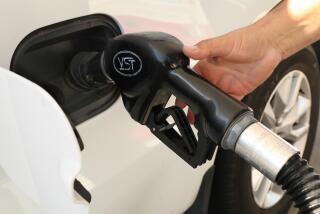Gas Station Customers Get Oily Promises
- Share via
It’s not just station banners saying, “Now credit is the same price as cash.” It’s billing inserts announcing “the same low price” for credit customers and letters telling them that charging gas “no longer means paying a higher price than the cash customer.”
Seems simple. Given the choice and arrangement of words, most people understand that credit prices are coming down to the cash discount price.
But it’s just words. Some Chevron stations raised their cash price, some dropped their credit price. At least one dropped to cash price at the self-serve island and raised to credit price at full-serve. “They’re independent businesses,” says Bill Berghoff, Chevron’s head of retail brand services, “free to set prices as they choose.”
The inconsistency between corporate promise and corner pump shouldn’t be surprising. This is a business in which few people can even say what they pay for gas because it keeps changing. Nor do they always know what they’re about to pay for gas: Drawn by signs saying $.89.9, they could conceivably be charged $1.39.9, says Steve Shelton, executive director of the Southern California Service Station Assn. in Irvine, because “they used the wrong island or the wrong pump.”
This is an odd business, both wholesale and retail, in which the relationships seem to foster not competition but complication. Technically, it may be free enterprise, as the industry keeps insisting, but for the consumer, it’s a heavily manipulated mess.
It’s a business in which oil companies describe their dealers as independent businessmen and dealers, says Shelton, feel as if they are “economic serfs.” Whether their stations are company-owned, leased or truly independent (simply contracting for supplies), they do seem subject to odd company controls.
Dealers once protested short-term leases that threatened 30-day termination if they didn’t follow prescribed sales. Now there are rent discounts for the amount of product sold, leases (and even sales contracts) dictating the number of gallons that must be sold or the hours of operation (24-hour operation, common now, may cost dealers more than it’s worth).
Oil companies often charge their dealers for handling credit transactions, as if the companies were simply intermediaries, like American Express. But they profit from the sale and the relationship: Card customers, says Sheila Taylor, coordinator of Chevron’s new “single price” program, are “more loyal, buy more and higher-grade products and come back more often.”
The companies also set the marketing approach and then advertise it to consumers. Although dealer participation is “optional,” oil companies naturally prefer “consistency,” says Berghoff, encouraging dealers “through counseling and incentives.” (“Counsel” is the industry word for company orders to dealers.) Then they have it both ways, telling consumers--as in the Chevron campaign--that whatever the company promises, dealers can do what they want.
Partly as a result, the retail relationship is equally odd. Most consumers associate station with brand, and “generally view the dealer as a company employee,” says Berghoff. This is reassuring, particularly when they’re getting repairs (if the dealer still does repairs).
Indeed, most companies have customer relations departments to take consumer complaints. But they may only stand behind the product, not the service: “We wouldn’t take responsibility for a dealer’s actions,” says Stu McDonald, Atlantic Richfield’s vice president of distribution, “like on a repair job.” And they can always say the dealer is an “independent operator,” as Chevron does when someone complains his credit price wasn’t “the same low price” as cash.
Given the decline in service and the sameness of product, pricing is everything now, though there’s some question how discerning consumers are. Arco believes, says McDonald, that “people will switch for a penny a gallon.” Chevron, says Taylor, thinks “most customers are not terribly price-sensitive within a couple of cents.”
How can they be, with gas prices constantly changing, from day to day, city to city, block to block, pump to pump? And beyond the dealer variations, there’s company manipulation, particularly since the early 1980s, after several gas crises and a rapid rise in gas prices in relatively few years.
Sensing a simple demand for lower prices, the industry came up with complications. Most companies went to two tiers of service, self-serve and full-serve, differently priced. Many also went to two tiers of prices, credit and cash, explaining that cash customers (a majority) shouldn’t be subsidizing credit card transactions--either the company’s handling costs or the 3% fee typically charged to the dealer. Arco even went to no tiers, lowering prices by entirely eliminating such “frills” as full service and credit cards.
The result has been a plethora of prices, a forest of signs (some posting cash prices, some credit, some both), and a pricing structure of no great gain for consumers. Companies expected a 4-cent discount for cash; dealers offered 5 cents, even 10, and soon “the credit customer was subsidizing the cash customer,” says Shelton. Worse, cash discount programs rely on money back at point of payment--”a nightmare to enforce,” says Shelton--and it’s said that 20% to 30% of people don’t get their money at all.
Chevron’s answer to this mess is the “single price” program, starting with 4,000 of the company’s 13,000 stations. It specifically woos card users, implying that their credit price will be coming down, but appeases cash customers with its implication that their price will stay the same--low.
But it’s all implication. Even the company expected, says Berghoff, “that credit would be lowered and cash would rise.” But anything can happen, given the dealer’s freedom to do as he likes, even under the advertising banner.
Some promise. Some mess.
More to Read
Inside the business of entertainment
The Wide Shot brings you news, analysis and insights on everything from streaming wars to production — and what it all means for the future.
You may occasionally receive promotional content from the Los Angeles Times.










